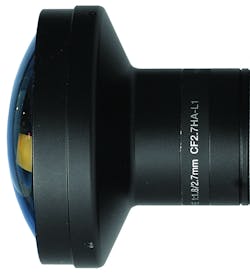If you ever want to experience a distorted view of the world, try looking through someone else’s prescription eyeglasses.
To see things normally, you need lenses that compensate for the particular characteristics of your eyes and the particular conditions of your surroundings — whether for myopia or astigmatism, staring at a computer screen all day or driving at night facing glaring headlights.
In the world of video surveillance, your cameras face a similar challenge. A video camera’s image sensor is much like an eye, while the lens serves the same role as a pair of prescription eyeglasses. For your camera to attain 20/20 vision, it needs to be fitted with the right lens for the job.
The basics of lens selection have not changed much over the years. You still need to choose a lens mount, determine the appropriate focal length, and match the lens to the surveillance environment — whether indoors or outdoors. But with some of the newer network camera technologies, such as megapixel and HDTV resolution, lens selection becomes even more critical for optimum performance. The following are some of the key issues you need to consider when seeking the right lens for your surveillance application.
Matching Lens to Sensor
A camera “sees” when light passes through a lens and is then focused on the camera’s image sensor. The image sensor is made up of many tiny photosites, and each photosite corresponds to a picture element, more commonly known as a “pixel.” Each pixel on an image sensor registers the amount of light it is exposed to and converts that light into a corresponding number of electrons. The brighter the light, the more electrons are generated.
Image sensors come in a range of sizes, most commonly one-quarter to one-third of an inch — so you need to make sure to choose the right sized lens for the sensor. If the lens is rated for a smaller image sensor than the one inside the camera, the field of view will have black corners. Conversely, if the lens is rated for a larger image sensor than the one inside the camera, you will lose some of the field of view outside the image sensor range (see figure 1, page 25). This situation creates a telephoto effect, making everything look zoomed in.
In the case of a megapixel or HDTV camera, you need a high-quality lens, since these sensors have pixels that are much smaller than those on a VGA sensor. The pixels must be smaller in order to fit that many more on the sensor. For instance, a 720p camera with 1280 x 720 pixels has three times as many pixels as a VGA camera, which has 640 x 480 pixels. To fully use the camera’s capability, the lens and camera resolutions should match.
Picking the Right Lens Mount
Network cameras use one of two standard mounts: CS-mount and C-mount. They both have 1-inch thread and look the same. Where they differ is in the distance from the lens to the sensor when fitted on the camera. If you find it impossible to focus the camera, it is likely that you attached the wrong type of lens mount.
In a CS-mount, the most common lens mount, the distance between the sensor and the lens should be 12.5 mm; in a C-mount, the distance between the sensor and the lens should be 17.526 mm.
Choosing the Right
Focal Length
A lens’ focal length is defined as the distance between the entrance of light into the lens and the point where the light rays converge on the image sensor. The general rule is that the longer the focal length, the narrower the field of view. There are three types of fields of view:
• Normal — a view that most closely corresponds to how the human eye sees;
• Telephoto — a narrower field of view that generally provides finer details than can be detected by the human eye; and
• Wide angle — a larger field of view with less detail than seen by the human eye.
Correspondingly, there are also three main types of lenses:
• Fixed only provides one type of field of view (normal, telephoto OR wide angle).
• Varifocal offers a range of focal lengths and different manually adjustable fields of view. Whenever you change the field of view, you need to manually refocus the lens. Remote focusing capabilities have been added to the latest generation of network cameras, enabling you to focus the camera from a remotely-located computer instead of while up on a ladder or lift.
• Zoom offers a range of focal lengths and different adjustable fields of view. Unlike varifocal lenses, zoom lenses do not require refocus of the lens if you change the field of view. They automatically maintain focus within a range of focal lengths, such as 6 mm to 48 mm. You can adjust zoom lenses manually or remotely through motorized control.
Deciding on an Iris Control
Another important factor in image quality is how you control a camera’s iris opening. The iris — which lets in a specific amount of light depending on the size of its opening — controls the depth of field and maintains the optimum light level to the image sensor so that the image appears sharp, clear and correctly exposed with good contrast and resolution. Iris control can be fixed or adjustable.
• Fixed iris control is set at a certain f-number and the opening cannot be adjusted. It is most appropriate for indoor environments with constant light levels.
• Manual control allows you to adjust the iris opening by turning a ring on the lens. Like a fixed control, it works best where light levels are constant.
• DC-iris, also known as auto-iris control, uses the camera’s processor to automatically adjust the aperture (opening of the iris) to changing light conditions. The DC-iris only has two aperture settings — small and large. It cannot be fine-tuned to an exact iris position.
• P-iris control provides an automatic, more precise aperture as it uses special software to communicate with and control the iris’ exact position to manage even the slightest change in light. This provides better, “precise” control to optimize contrast, clarity, resolution and depth of field. The P-iris control also eliminates the blurring problems that may occur with DC-iris control, which is especially important in high-resolution cameras such as 3- and 5-megapixel.
Choosing the Right Resolution
Different surveillance objectives require different resolutions, so you need to select a camera and lens that match the field of view to the size of the scene you want to capture. If your only goal is to detect an individual in a scene, a lens with a linear resolution of 20 pixels per meter would probably be sufficient. For forensic detail such as a license plate number, the linear resolution would need to be around 200 pixels per meter. For facial identification purposes, the resolution would have to be closer to 500 pixels per meter.
Check that the megapixel rating for the lens matches the megapixel rating of the camera. Image quality suffers when you use a non-megapixel rated lens on a megapixel camera or even a lower-resolution megapixel lens on a higher-resolution megapixel camera.
Compensating for
Infrared Lighting
Lenses often experience color distortion called chromatic aberration. This occurs because lenses have different refractive indices for different wavelengths of light and every color in the optical spectrum cannot be focused on a single common point. The aberration often manifests itself as fringes of color along boundaries that separate dark and bright parts of the image. Choosing an achromatic lens — a compound of different materials with differing light dispersions — reduces the amount of chromatic aberration over a certain range of wavelengths, though it does not eliminate the distortion altogether.
If you are using a day/night camera, be sure the lens includes an IR cut filter on the lens that can be automatically or manually removed depending on lighting conditions. That way, when surveillance occurs under infrared lighting conditions, the lens will not trigger a shift in focus and color distortion.
Specialty Lenses
Specialty lenses compensate for a host of problems. For instance, a wide-angle, low barrel distortion lens offsets barrel distortion caused by lens magnification being smaller at the edges of the field of view compared to the center of the image. This phenomenon is often more pronounced at short focal lengths, making a standard wide-angle lens less suited for identification purposes.
Motorized optical and digital zoom lenses with auto focus enable remote manipulation the camera, zooming in on small or distant objects with exceptional clarity. When the camera faces direct sunlight, putting a polarized light filter can improve the camera’s light sensitivity and image quality.
Final Recommendations
As with any technology, the science of camera lens-making continues to make advances — though nowhere close to the rapid pace of improvements in semi-conductors and image processors. Like all leading-edge improvements, pricing will fluctuate depending on the quality of the lens and the features it includes. For instance, a low-cost fixed iris lens could be found for as low as $10, while a varifocal P-iris lens for a 5 megapixel camera could cost several hundred dollars, and a zoom lens even more.
Comparable to professional SLR still photography cameras, the lens is often the surveillance camera’s most expensive component. Often, buying a camera with the lens included provides optimum price performance — so shop wisely. Compare costs and features across multiple manufacturers to make sure the type of lens you choose is the perfect fit for you. ?
Fredrik Nilsson is General Manager of the Americas for Axis Communications and author of the book Intelligent Network Video. He is a regular expert contributor on topics of networked video surveillance systems and cameras, including his “Eye on Video” and “Eye on Hosted Video” series available at www.SecurityInfoWatch.com.
About the Author

Fredrik Nilsson
Fredrik Nilsson is VP Americas for Axis Communications, and is the author of “Intelligent Network Video: Understanding Modern Video Surveillance Systems” published by CRC Press and now in its second edition. www.axis.com
Request more info about Axis at www.securityinfowatch.com/10212966.
